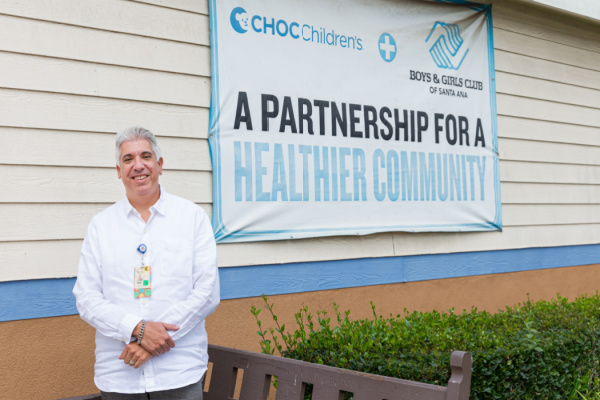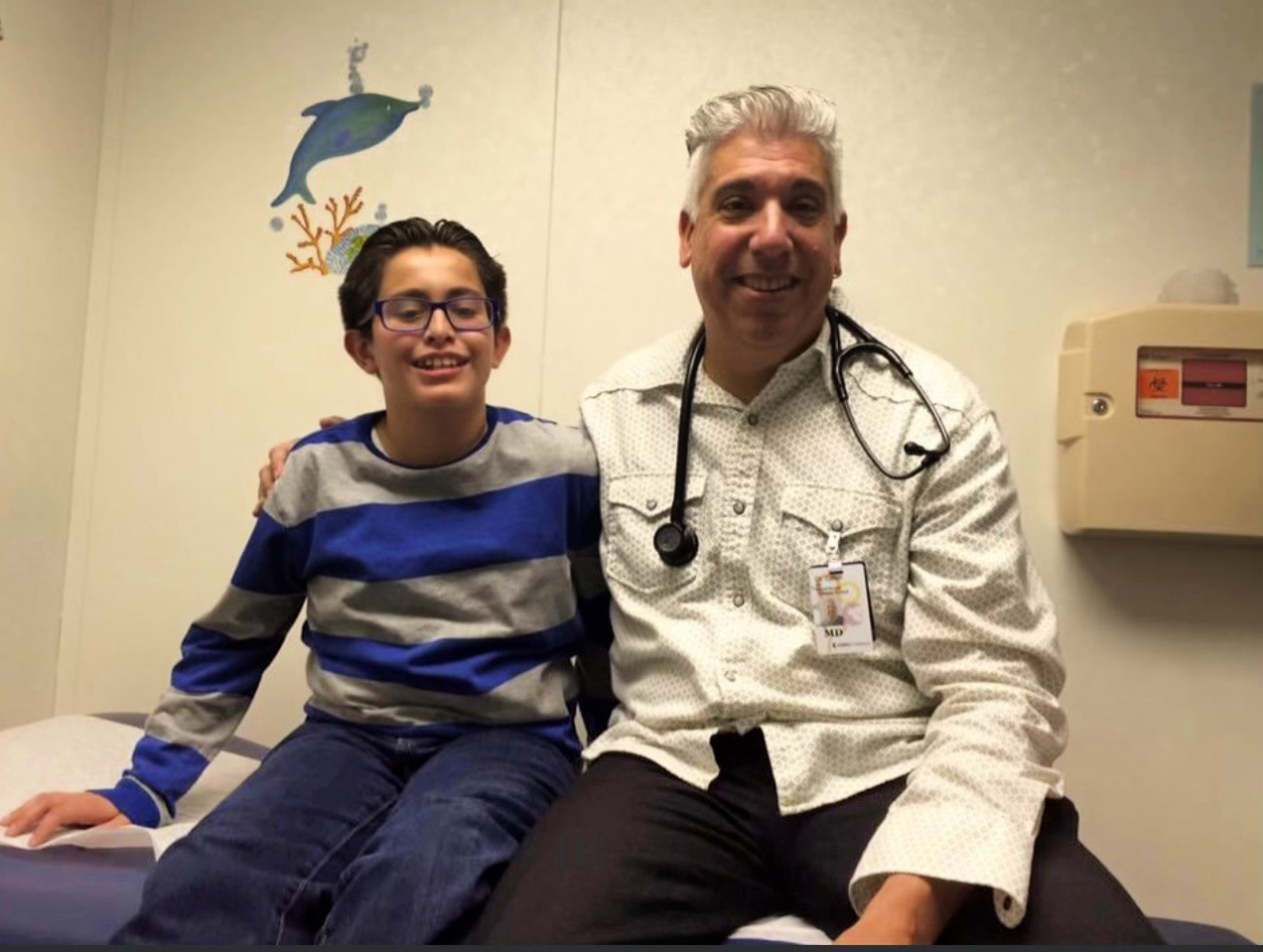Since 1998, CHOC pediatrician Dr. Mark Colon has been providing care at CHOC’s Santa Ana clinic at the Boys & Girls Club – the first freestanding, full-service clinic located at a Boys & Girls Club in the nation.

This year, Dr. Colon was presented the 2021 DreamMaker Award by the Boys & Girls Clubs of Central Orange Coast, in part for creating a health-and-safety protocol last year in response to COVID-19 that has become a model for Boys & Girls Clubs around the country.
Dr. Colon, a first generation Mexican American who was born in Lynwood and raised in Brea, has an affinity for the area’s Latinx community and underserved youth – and is incredibly beloved in his community.
Gabriela Velasco has seen Dr. Colon for years: Her 15-year-old son Jair has been under Dr. Colon’s care since infancy, and Dr. Colon has helped the family navigate complex medical needs.
But beyond her own family, Gabriela has seen firsthand Dr. Colon’s impact on the Pico Pio neighborhood – named after the elementary school across the street from the clinic. She lived and worked in the area at the time of the launch of the clinic, where Dr. Colon has worked since its opening, and she’s watched how the community has changed ever since.
“When the clinic first started, a lot of people didn’t believe the doctors,” she said. “And now they believe him. Dr. Colon is my biggest inspiration. He could work in any type of clinic, but he chose this neighborhood because he knows we have the biggest need. He’s inspired us to be the best parents we can be.”
We recently caught up with Dr. Colon on his career; how the community and his patients have inspired him; and what the clinic means for patients and families in the community.
Q: What has been the evolution of your career?
A: From a young age, I told my mom I wanted to be a “hospital man” when I grew up. Although there were no doctors in my family, I had some ear issues and related surgeries as a child. Also, since my grandparents lived with us, I would often tag along to their medical appointments before I was school-aged, which provided more exposure to doctors. After I completed medical school, I did my residency at CHOC and then stayed an extra year to serve as chief resident. After completing all my training, I’ve spent most all of my career with CHOC at the Boys & Girls Club clinic. Yes, what I do is work, but it’s more of a joy. I feel blessed to be able to do what I do.
Q: What is your relationship with your patients and families like?
A: I always knew I wanted to go into pediatrics. I knew I wanted to serve a population that is dear to my heart. Serving my population, at the beginning I thought they needed doctors in these areas, and I thought, “Great; I can help with that.” But through the years, my patients and families have taught me more than I could teach them – they teach me how to be grateful, the importance of kindness, and they have solidified what my parents taught me that family is the most important thing you have in life. It’s been a very symbiotic relationship. Even if they come from humble backgrounds, the generosity they show and how they seek joy in life is very touching.

Q: What are your special clinical interests?
A: As a pediatrician, I often refer to myself as a sniffles doctor. Being part of CHOC, we see much more than just seasonal illnesses that send kids to the pediatrician, and our clinic sees patients with chronic illnesses as well. One area that I love talking to kids about – whether they’re in to see me for a cold or a chronic condition – is their future. There are spaces in the visit, like when examining their ear, where I can make conversation and ask things like, “What do you want to be when you grow up?” I like to help them think about their future.
Usually when I ask my patients, “What does a doctor look like?” they say things like doctors wear white coats and stethoscopes. I tell them a doctor looks like everyone else – it’s not a certain look but a desire that you have. Just because you don’t have a doctor in your family, doesn’t mean you can’t do that.
Reading is directly linked to a child’s success, and I’m passionate about the Reach Out and Read program, a national nonprofit that gives young children a foundation for success by incorporating books into pediatric care and encouraging families to read to and with their children. We are lucky to have this program at CHOC, and I’m fortunate to be part of it. Kids who are read to like books; kids who like books like to read; and kids who like to read are better suited students. Also, reading helps develop their imaginations.
Q: What would you most like the community to know about the Boys & Girls Club clinic?
A: CHOC has always welcomed the chance to work with community partners like the Boys & Girls Club of Santa Ana. We are fortunate to have a wonderful relationship with Boys & Girls Club, and we have a shared goal of bringing much-needed services to the community. Just one example of our collaborative efforts over the last 20 years is meeting the need for fresh produce, through a partnership with Second Harvest. Families in our community lack sufficient supermarket options, and we wanted to bring fresh food and more options to them.
As a pediatrician, yes I’m here to take care of my patients’ physical health, but studies show that if you’re not psychologically in a good mind frame, it can affect your health. We provide robust services to care for our whole patient, whether it is issues with food insecurity or providing psychological help by having a psychologist readily available to our patients.
Q: How do you make special connections to your patients?
A: I wear two different shoes to break the ice with my patients. This tradition started in residency. I wear one white tennis shoe and one black, though they are the same style. With my younger patients, it breaks the ice and I find they won’t be as timid with me coming in the room to talk to their parents and examine them.
I also choose not to wear a white coat. There’s nothing wrong with doctors wearing them, but in my clinic, I want to demystify the experience of coming to the doctor. If they think, “Oh, there’s the doctor; I shouldn’t ask this or that,” they won’t open up. If they feel comfortable, they are going to tell me a lot more about what’s going on and how I can help them, than if they feel uncomfortable.
Q: How do you approach building relationships with the parents of your patients?
A: Sometimes, doctors are in the mode of telling, telling, telling. But I first need to listen. If you listen more, families will tell you more than if you’re always the one talking. I want to have a conversation with my parents instead of lecturing them.
If I give recommendations, I say, “These are my recommendations, but you’re the parent. We are in a partnership. It’s ultimately your decision.”
For example, if I am talking to a mother who is having trouble getting her child to go to sleep at a certain time, and I don’t know their history about why they are struggling, and if I don’t know the background, my solution might not be feasible for them. Or some of the advice I gave them wouldn’t work. That doesn’t mean the advice was bad, but it might not be practical.
I ask my parents, “Do you understand what I just said?” If they don’t, that’s a “me” problem. It means I didn’t explain it well enough. Then I try again to explain things in a different way.
Q: What inspires you most about the care being delivered at the Boys & Girls Club clinic?
A: The staff here is remarkable. Life is so much easier when you’re around people who are positive. Not everything in everyone’s life is perfect, but when we come to CHOC, we say, “How can we make this day the best experience for our families and patients?”
For us, it’s all about the families we have the privilege to care for – the families I take care of, they are part of my community. We are like a big family. When they come into the clinic, it’s like seeing an old friend.
Dr. Colon was presented with the Boys & Girls Club 2021 DreamMaker Award at the club’s “Be Great” gala on Oct. 23. You can watch a recording of the event here.




